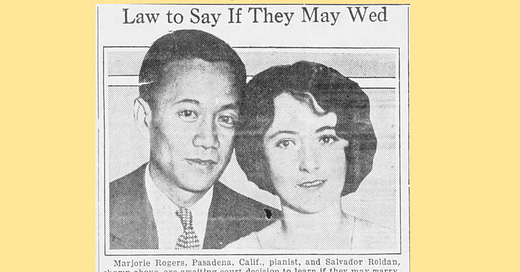9. The marriage that California fought and then invalidated
In the 1930s, Marjorie Rogers and Salvador Roldan had to go to the California Supreme Court to get a marriage license because she was white and he was Filipino
Marjorie Rogers and Salvador Roldan were in love, but getting married took a three-year court battle and led to a change in California law. Why? Because she was white and he was Filipino.
In the early 20th century, California was one of many states that had a ban on interracial marriages. The specific nature of the ban varied by state, with some states banning all marriages between a white person and someone who was not white. California’s law was not as broad – the law had originally prohibited marriages of white persons with “Negroes” or “mulattoes,” and then was expanded in 1901 to ban marriages of white persons with “Mongolians.”
Salvador and Marjorie met on tennis courts. She was a pianist from England, and he was a “houseboy” who was so poor when they met that she had to lend him two dollars for their first date.
Salvador and Marjorie argued that they were entitled to a marriage license because he was not Mongolian, but of the Malay race. Naturalists such as J.F. Blumenbach had generally classified humanity into five races – African, American, Caucasian, Malay, and Mongolian – and courts at the time often looked to such classifications to interpret race-specific laws.
Their case ultimately went to the California Supreme Court, and the court ruled in 1933 that the state law regarding “Mongolians” was intended to bar only marriages with the Chinese, “the class of residents whose presence caused the problem at which all the legislation was directed,” and “possibly contiguous peoples of like characteristics.” As written, the law did not go so far as to include the Malay race.
Salvador Roldan and Marjorie Rogers quickly got a marriage license and got married in what one newspaper called a “simple chapel service.”
“Miss Rogers and Roldan seemed very much in love and as they had the proper credentials, I married them,” the pastor who officiated the wedding told a reporter.
They were right not to wait. Within months, California’s legislature amended the state ban, which prevented the issuance of future marriage licenses to marriages like theirs.
“In the eyes of the State, Mom and Dad’s marriage lasted from April 10, 1933 to August 20, 1933. It was a bizarre legislative mandate, highlighting the almost hysterical lengths people would go to in order to achieve racial purity,” their son Bryan said in a 2022 article.
California’s ban on interracial marriages stood for 15 years, ending in 1948, when the California Supreme Court became the first high court to strike down a ban on interracial marriages for violating the U.S. Constitution. Two decades later, in 1967, the United States Supreme Court struck down all remaining state bans on interracial marriage in Loving v. Virginia.
In 2016, the California State Assembly passed a resolution apologizing to the Roldan family.
Sources: Roldan v. Los Angeles County, 129 Call. App. 267 (California 1933). “Filipino Weds Caucasian in Simple Chapel Service,” Pasadena Post, April 11, 1933. Susie Ling with Bryan Roldan, “One Love Story Behind Marriage Rights: The Roldan Family,” East Wind ezine, July 20, 2022, online here. Photo from the Lindsay Gazette, October 23, 1931.
About the Author: I am a lawyer in Chicago and previously was a federal prosecutor and a journalist.



